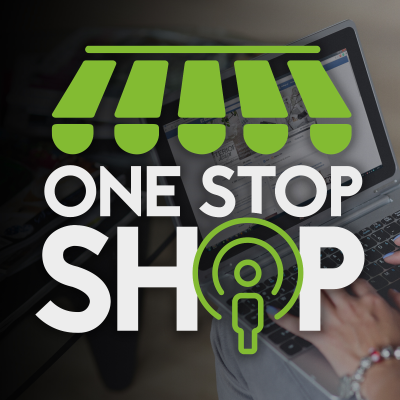
One Stop Shop
Podkast av Adii Pienaar
Anyone who's ever built a business will tell you that it's not easy, and the road is often lonely and full of doubts. Ecommerce business owners are used to figuring things out on their own, but it doesn't always have to be that way: To know the way, ask someone who's been there before. One Stop Shop is Conversio’s (previously Receiptful’s) weekly Podcast with the goal of helping ambitious Ecommerce merchants learn from the best. Every week we'll have a successful business person tell us their story, from their humble beginnings and obstacles, to their triumphs and success, and how they got to where they are today. Tune in every week for a new episode with tips, strategies, and information to grow your online Ecommerce business.”
Prøv gratis i 7 dager
99,00 kr / Måned etter prøveperioden.Avslutt når som helst.
Alle episoder
87 Episoder1. Finish the process. It’s like planting a tree: it’s better to plant a coconut tree first and take care of it until it grows fully, rather than to plant a coconut seed first, then change your mind and replace it with a mango seed, then with an avocado seed, then with an orange seed – if you do it this way, you’ll never see your tree grow because you didn’t stick with it long enough. Focus on a single marketing strategy first and stick with it until you reach the point of learning where you’ll learn one of the following: How valuable something is to your business’ growth. For example, this strategy is effective since it added $500/month into your revenue. Great! How can you work on this so it’ll grow to $1,000/month or even more? Or; How not valuable something is to your business’ growth: If it’s not moving the needle, and you don’t see any significant results happening, then great! At least you learned from it so you can now move onto testing other strategies that may work for you. You can only reach this point of learning when you “exhaust” a specific tactic – when you start it, stick with it, and eventually get to the bottom of it. 2. Focus on the ones with positive results. Once you’ve done this, the next part is focusing on the strategies that work for you and doubling down on them. Take your customer support, for example. If your customer support is top-notch and you can convert 50 customers a month through referrals alone, you know it works, so how can you double down on this? 3. Figure out how you can improve it. You want to get the best results that can help grow your ecommerce store over time, right? In our example earlier, perhaps you can automate the administrative tasks associated with this so you can deliver a more personal touch to every customer interaction and increase your conversion to 100 customers a month? There isn’t a marketing strategy that’s one-size-fits-all, so dedicate some of your resources to find out what works for you and then making the best out of it. Two caveats on this advice, though: In my earlier video about “The Last 5% May Not Be Worth It” [https://conversio.com/academy/the-last-5-is-probably-not-worth-it/], I talk about the idea that even if you’re doubling down on something, you’ll reach a point where the marginal gain won’t be the same anymore since you’ve already reached the point of learning. You don’t need to double down on a specific strategy forever. Once you’ve reached this point where there’s no obvious viable improvement anymore, it’s time to move on to the implementation of the next strategy. Also, remember the Pareto principle which says that 80% of your sales comes from 20% of your top marketing strategies? It applies to this concept, too. You can spend 80% of your time working on the strategies I’ve mentioned on this blog post today, and then spend the remaining 20% into experimentation. Go ahead and try out something completely new, something you’ve never heard of before, or maybe even something that’s trending in your industry today, and find out if it works for you. If it does, then, double down on it until you reach the point of learning again. I hope this concept can help you grow your business by focusing on a tried-and-tested system that works and optimizing it for the best results for you. This way, there’s a certain reliability factor that can help you move forward efficiently and effectively so you can reach that much desired sustainability of your business. See you again next week, then! Cheers.
1. Consolidate your customer communications in a central inbox. Simply put, use a help desk software so you have a central platform that focuses solely on customer service needs. I know what you’re thinking -- you need to spend money! But before you close this tab on your browser, hear me out first: a) there are lots of help desk solutions out there so you’re guaranteed to find one that fits your budget; and b) it’s worth investing in this platform because you don’t want any customer communication to fall through the cracks, do you? If you don’t have any central inbox to consolidate your customer communications, there’s a higher chance that a customer’s message will be forgotten, overlooked, or even accidentally ignored. The #1 reason why customers switch to a new brand is because they feel underappreciated [https://www.vonage.com/business/perspectives/the-62-billion-customer-service-scared-away-infographic/]. Not replying to your customer’s message sends them the message that you don’t care about them. And you don’t want this to happen, do you? It’s also more convenient to onboard other team members to help you with customer service if you have a central customer service platform to train them on. This way, the process is more streamlined, structured and easier to get the hang of. 2. Be owner-involved in customer service. Your customers are the life of your business. If you don’t have any happy customers, you won’t have any business in the first place! That’s why it’s important for you to be involved in customer service and interact with your customers as well. This way, you can learn from them, find out what areas of your business you need to improve on, and generally keep your pulse on your business. Sure, you also need to delegate customer service to your trusted team members, and you also need the time to work on other areas of your business, but whenever you have extra time, you can also do customer service-related tasks accordingly. 3. Build a knowledge base of documentation and canned replies. Customers prefer knowledge bases [https://www.forrester.com/report/2018+Customer+Service+Trends+How+Operations+Become+Faster+Cheaper+And+Yet+More+Human/-/E-RES142291] over other self-service channels. You can build your own brand’s knowledge base by taking note of frequently asked questions and the most common customer concerns whenever you respond to your customers’ messages. Check your customer support inbox. What are your customers’ top ten most common concerns? What do they usually complain about? What needs do your customers want to be taken cared of? Create a list of articles about these and direct your customers’ attention to these articles as necessary. You can also craft high fidelity, detailed replies that answer their most common concerns. Use these as templates that you can personalize and tweak before sending to specific customers. Doing this helps you kill three birds with one stone: You save valuable resources in responding to your customer’s concern; Your customers receive personalized messages that help resolve their concern; and, You can quickly onboard your customer service team because there’s already a knowledge base they can refer to and a collection of detailed templates they can use 4. Beware of live chat. Yes, in today’s world of instant gratification, offering a live chat function makes sense. After all, 42% of customers want to communicate with companies via live chat [https://blog.hubspot.com/news-trends/live-chat-go-to-market-flaw]. If you can respond within 5 minutes of your customer’s message, and you can do this consistently, then offer live chat. But if you’re not available to respond within 5 minutes, it’s better for you not to offer live chat in the first place. Imagine sending someone a live chat message and not getting any reply after 5-10 minutes -- you’d feel underappreciated, too, wouldn’t you? Here’s a better solution: direct them to email instead. More customers (62%) prefer email over live chat (42%) anyway. Include a reminder that your customer service team will get back to them in an hour or two. This way, your customer’s expectations are managed better. Additionally, customers believe that emails should be responded to within 24 hours [https://www.drift.com/blog/chatbots-report/], so if you respond within 1-2 hours, then your customers will be pleasantly surprised. Another win for the both of you, don’t you think? Hopefully these tips can help you have better structures and subsequently, better conversations with your customers! That’s it for me today - now, over to you. What tip do you think is the easiest to start working on? Let me know in the comments below. See you next week! Cheers.
1. Figure out your skills and focus on the business-related activities you enjoy. The idea of “do what you love and you never have to work another day in your life” seemed to be a lie - when you were starting out in business, you didn’t have the luxury to do only the things you love because you had to do a lot of things, even things you don’t necessarily enjoy doing. Now that you’re scaling your business, though, you’ll have the joy of sitting down, figuring out what your greatest strengths & enjoyable tasks are, and delegating them to someone else in your team. Do you want to focus more on sales and spend less time on bookkeeping? Or spend 80% of your time on product development to build a sustainable business, so you want to delegate your inventory-related tasks to someone else? Find out what your weaknesses or your least enjoyable tasks are. Then, delegate them to someone who’s more qualified than you are. Your investment on doing proper delegation will be worth it. After all, you’re in it for the long run, right? 2. Hire a part-time assistant to help you with customer service and support. As an entrepreneur, your mental space is one of your greatest assets. That’s why it’s important that you hire a virtual assistant or a freelancer (even on a part-time basis!) to clear up some of your mental overhead. This way, you don’t exhaust your mental energy by focusing on these tasks only: you’re still involved with customer support and service, but you’ll have an assistant helping you along the way. Like the captain of a ship, you’ll still be in charge as you supervise your crew as sail through the rough seas. You get to prevent burnout and improve your customer service at the same time. Talk about hitting two birds with one stone, right? 3. Batch similar tasks as much as possible. Batching is a productivity hack that encourages you to do similar tasks all at once. Think of batching as grocery-shopping: you don’t want go to the store every single day to pick up food, right? You’d waste your precious time and energy! Instead, you sit down, take note of your stock, plan your meals, and go to the grocery every week. Personally, since I release weekly videos for Conversio, I batch my video recordings accordingly. This allows me to maximize my productivity and optimize my mental space to focus on a specific task for a scheduled period of time. You can batch customer support and product shipping by doing them everyday - but only on specific schedules like doing them for an hour during morning and afternoon, instead of getting stuck on doing them several times in a day. Additionally, you can also dedicate a specific time to batch a whole week’s social media content once a week. Or even batch your email newsletters by drafting them one month in advance. There you have it. I hope these tips will help you scale your business successfully, without losing your sanity! As entrepreneurs, we should not be burning out - even the longest candle will burn out if you light it forever. That’s why I’ve made these tips that I hope you find helpful. Let me know what your valuable insights are, and see you again next week! Learn with our FREE Ecommerce Academy: conversio.com/academy [https://conversio.com/academy/] Music featured in this episode was "Celery Man" by Birocratic and can be found at @birocratic.
1. Monitor your bad reviews so you can respond on a timely manner. Have a system that notifies you each time you receive a bad review. For example, with Conversio, you can choose to be notified of reviews which achieve a certain rating (or less) and you customize the rating level. So you might pick 3 stars or less, or 1 star ratings only. Strike while the iron is hot so you can increase the possibility of your customer engaging with you. This can also diffuse the tension and communicate how much you care about your customers. On average, 53% of customers expect businesses to reply to their online reviews within seven days [https://www.reviewtrackers.com/reports/online-reviews-survey/] so can you imagine the positive impact to your customer when you reply to their online review in less than an hour? 2. Empathize with your customer and never ever be defensive. Be sincere when apologizing but be objective when assessing the bad review you’ve received. Start with a sincere “Hey, John, I’m really sorry about [reason why they’re upset].” This statement shows that you’re listening to them – you’re open to start a meaningful conversation with them and you’re accepting that the situation may be something that you’re partly responsible for. Once you’ve apologized, address the customer’s concern or issue and fix it accordingly. If they’ve received a defective product, apologize and tell them that you’ve sent a replacement immediately. If they’ve received an item on a later date than expected, you can’t really fix slow delivery since it already happened. So if you can’t fix something that already happened, offer a simple compensation to make up for your mistake. Giving them store credit, a discount code, a freebie or even a refund (in extreme cases) works. Just remember to always apologize first. After all, 37% of customers are satisfied with service recovery when they are offered something of monetary value (e.g., a refund or credit) but their satisfaction doubles to 74% when there’s an apology [https://www.groovehq.com/support/customer-support-statistics] on top of the compensation. The goal here is to improve your customer’s impression of you: from a one-star review, perhaps you can shift it to a 4-star or even a 5-star review instead. Sounds corny, but handling a bad review is like turning your customer’s frown upside down. Not everyone will be 100% pleased with your product & service, but it’s worth a try, right? 3. If you were successful in improving your customer’s impression of your business, ask for an updated review. Once you’ve established that your customer is now satisfied with the resolution of their concern, and you’ve managed to turn that frown upside down, it’s now time to ask for an updated review from them. With Conversio, they can simply submit a new review via the email request or review form and it will overwrite the old one. It’s better if they mention that they had concerns before, and that you were helpful in rectifying this. This way, you’re not only selling your high-quality product – you’re also guaranteeing great customer service to go with the product you’re offering. Not to mention the added bonus that if you resolve a complaint in your customer’s favor, they’ll do business with you again 70% of the time. [https://www.livechatinc.com/blog/customer-complaints/] And who would say no to repeated customers, right? Hopefully, this three-step process helps you to better address bad reviews in the future.
As an entrepreneur for nearly 13 years, I’ve had two life-changing realizations: One, wow, has it been more than a decade already? And two, there’s no such thing as a perfect entrepreneur or a 100% successful venture. Spending all your time, energy and resources to achieve perfection might not be viable anymore, considering that your to-do list as an entrepreneur is seemingly never-ending. Sometimes, the last 5% is probably not worth it. Talking about this reminds me of the blog post that Derek Sivers, CD Baby founder, wrote entitled “Relax for the same result” [https://sivers.org/relax]. Derek used to bike 15 miles every day. He used to do full-on biking, as in pedal to the metal, red-faced, rockstar biking that left him exhausted. Doing this -- giving his full, maximum effort -- gave him 43 minutes. Over time, though, he started to link exhaustion and tiredness with the act of biking, so he felt tedious and less enthusiastic about it. That’s why he decided to give 50% of his usual effort instead. Doing so made him notice things, live in the present more, and actually enjoy his bike ride. The best part? His time was 45 minutes -- only two minutes more than his usual! So for him, giving 100% of his effort resulted in 43 minutes; whereas giving only 50% and taking it easy resulted in 45 minutes, plus, he even got to enjoy it more as he wasn’t stressed and wasn’t exhausted about the ride. Considering that the time difference between 100% effort and 50% effort was only 2 minutes, that last percent of effort didn’t give a significant result so it wasn’t probably worth it. It doesn’t matter how much the actual percentage is. What matters is that aiming for perfection -- for 100%, for the maximum effort -- in your business isn’t realistic. When you come to the point where the result you get isn’t really greater than the effort you make to get that result, it’s not viable anymore. After all, investing 50% of your resources and achieving 23% is much better than putting in 80% and receiving 25%, right? How does this translate to your business? Take email design, for example. In my video “How Anyone Can Design and Send Beautiful Emails”, I talked about not custom-designing your emails and sticking to tried-and-tested templates instead. Why? The trade-off isn’t viable. Your time, money, and effort to custom-design your email may be greater than the direct and indirect profit you receive from doing it. The marginal gains may be off and you may be better off developing other core components of your business that can achieve a significant impact in your company’s growth. Having two businesses worth multi-million dollars under my belt, I can say with absolute certainty that you don’t really need to achieve super-duper expert level in all aspects of your business. You don’t need to be perfect because perfection doesn’t exist. You can approach this with a bootstrapper’s mindset: when inputs are scarce, maximize the output. Because when your time, money and energy are limited, the best thing you need to do is to make the most out of it. Know the phrase, “get the best bang for your buck”? It’s similar, but you want to find the best bang for your time, money and energy. Another concept that applies to this idea is the Pareto principle: for many events, roughly 80% of the effects come from 20% of the causes. This means that for your business, 80% of the profit may come from 20% of your clients. Or 80% of your company’s growth may come from only 20% of your activities, such as setting up a better marketing funnel, or a more improved internal system for efficiency. The key here is to find the best input to output ratio so you can focus more of your resources into doing things that actually improve the growth of your business. I want to hear from you: have you ever had an experience where doing something in your business led you to the point of wondering if giving your absolute 100% resources is absolutely worthwhile? Let me know in the comments below. See you next week. Cheers.
Prøv gratis i 7 dager
99,00 kr / Måned etter prøveperioden.Avslutt når som helst.
Eksklusive podkaster
Uten reklame
Gratis podkaster
Lydbøker
20 timer i måneden



















